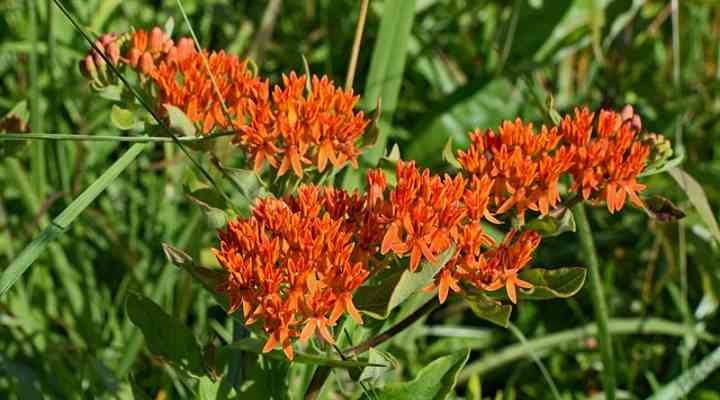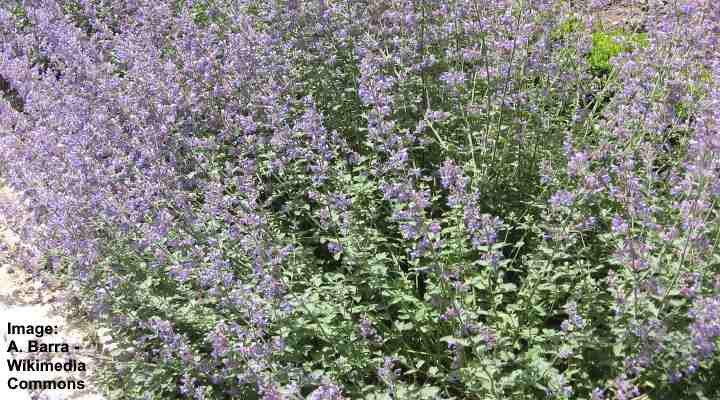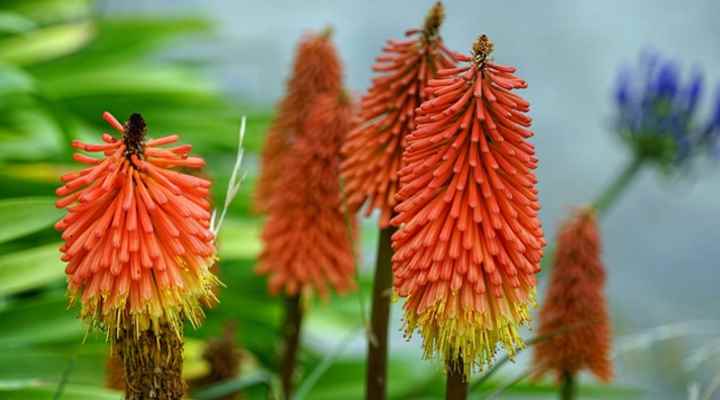The Best 19 Sun-Loving Perennials That Bloom All Summer (With Pictures)

Perennial flowers that thrive in full sun and bloom all summer are perfect for your garden landscape. Sun-loving plants like blanket flowers, coneflowers, yarrow, tickseed, and lantanas fill landscapes with color from late spring through fall. Full-sun perennials create stunning visual displays and add vibrancy to your outdoor space.
This article highlights the top perennials for full sun that bloom throughout summer. You will learn about the best perennial plants to create a vibrant and colorful garden that lasts all season.
Why Plant Sun Loving Perennials That Bloom All Summer?
Planting sun-loving perennials lets you enjoy a colorful, vibrant front or backyard all summer. Apart from their color, fragrance, and beauty, perennials for full sun attract native pollinators to benefit local ecosystems. Additionally, growing full-sun native plants in your garden requires little maintenance, and their blooms return year after year.
Sun Loving Perennials That Bloom All Summer (With Pictures)
Let’s look at 19 sun-loving perennials for full-sun gardens that will enhance curb appeal and add vibrancy to your backyard.
Black-Eyed Susan (Rudbeckia spp.)

Black-eyed Susan is an easy-care drought-tolerant flowering plant for full sun that well tolerates the summer heat
Black-eyed Susan is a group of tall perennial plants that love the heat and sun. The flowers are bright yellow daisy-like blooms with contrasting dark brown centers. The yellow flowers bloom profusely from early summer through late fall. Black-eyed Susans are easy to grow in sunny landscapes to provide eye-catching color.
Perennial black-eyed Susan flowers can be in shades of orange, yellow, and red. The upright, rigid stems have fuzzy lance-shaped leaves 3” to 7” (7.5 – 17 cm) long. The tall flowering stems are 1 to 2 ft. (0.3 – 0.6 m) high.
Thanks to the long-blooming season, black-eyed Susans add color to mixed borders, cottage gardens, or the back of beds when other flowers start to fade. Additionally, the low-maintenance flowers attract butterflies and bees to the garden.
Black-eyed Susans are suitable for growing in USDA zones 3 to 9 in well-drained soil. The plant is drought-tolerant and prefers to be grown in full sun.
Coneflower (Echinacea spp.)

Coneflowers are drought tolerant full sun perennials with flowers that attract pollinators and last all summer
Coneflower is a full sun perennial plant with showy ray flowers that bloom throughout the summer. The attractive daisy-like flowers are characterized by purple linear petals drooping from a dark brown cone-like center. The large, long-lasting blossoms come in pink, purple, orange, and red shades and thrive in sunny gardens.
Coneflowers are drought-tolerant plants for full sun, growing 3 to 4 ft. (1 — 1.2 m) tall. The eye-catching purple flowers are an excellent choice for garden borders, mass plantings, pollinator gardens, small groups, or cut flower arrangements. The plant’s natural self-seeding habit ensures a steady supply of beautiful flowers each year.
Coneflowers are easy to grow in well-drained neutral or slightly acidic soil and full sun in USDA zones 3 to 9.
Daylily (Hemerocallis spp.)

The sun-loving daylilies have a long blooming season and come in various colors
Daylilies are hardy, clump-forming perennials that thrive in full sunshine throughout summer. The herbaceous plants are well-known for their bright, showy trumpet-shaped blooms. These attractive flowers bloom in various colors, including red, yellow, orange, and pink. The plant’s flowering time is from spring through summer until frost.
Daylilies with grass-like leaves grow 1 to 3 ft. (0.3 – 1 m) tall and wide. The lush green arrow-like leaves, large funnel-like flowers, and sweet fragrance make them an excellent landscaping option for any garden. Daylilies thrive in full sunlight as colorful clumps in borders, mass plantings, and spreading as ground cover.
Daylilies are suitable for growing in USDA zones 3 to 9, depending on the variety.
Blanket Flower (Gaillardia spp.)

The beautiful blanket flowers give a bright focal point to sunny summer gardens
Blanket flowers are full sun drought-tolerant perennials producing masses of vibrantly colored daisy-like flowers. The ray flowers bloom from early summer through fall in yellow, orange, red, and burgundy shades. The pointed petals surround a central dark red disk. The blooms grow to 4” (10 cm) across and last from late spring to early fall.
Blanket flowers are an excellent plant for sun-drenched garden landscapes. The flowering compact mounds grow 1 to 3 ft. (0.3 – 1 m) tall and wide. The masses of colorful flowers are 2” to 3” (5 – 2.5 cm) wide. Blanket flowers are ideal for sunny perennial borders, butterfly gardens, and containers.
Blanket flower is suitable for growing in USDA zones 3 to 10 in well-drained soil.
Hardy Perennial Salvia (Salvia spp.)

The purple flowering spikes of salvia bloom throughout summer and grow well in sunny locations
Salvia is a hardy purple-flowering perennial plant that blooms for a long time in full sun. The eye-catching feature of hardy salvia is its flowering spikes of tiny tubular flowers of indigo-blue, purple, or violet colors. Blooming in late spring and through summer, the stunning flowers add vibrancy and texture to garden landscapes.
Hardy salvia is an easy-to-grow sun-loving perennial that requires little maintenance. Its clumps of aromatic leaves grow 1.5 to 3 ft. (0.5 – 1 m) tall and wide. The long-lasting blooms decorate perennial borders and cottage gardens or add color and texture to a foundation planting.
Salvia thrives in USDA zones 3 to 9 in full sunshine and well-drained soils.
Tickseed (Coreopsis spp.)

Tickseeds are hardy drought tolerant flowers that are common throughout summer
Many varieties of tickseed are heat and sun-loving, drought-tolerant plants with blooms that last the summer. Bright yellow, orange, and red flowers bloom in the summer, adding beauty to landscapes. The showy yellow or orange daisy-like flowers grow on the top of slender, wiry stems and measure 1” to 2” (2.5 – 5 cm) across.
Tickseed plants grow 0.5 to 4 ft. (0.15 – 1.2 m) tall, depending on the variety. The brightly-colored flowers are an excellent choice for landscaping a sunny garden. You can grow tickseed in beds and borders, driveway edges, rock gardens, or clumped together in containers.
Tickseed grows in USDA zones 3 to 10 and prefers well-drained soil; however, the flowers also thrive in poor environments like sandy and rocky soils.
Russian Sage (Perovskia atriplicifolia)

The heat and drought tolerant Russian sage is a versatile plant for sunny gardens
Russian Sage is a full sun woody perennial with tall, spiky stems that bloom in lilac shades from mid-summer through fall. The plant produces small, lavender-blue flowers that grow in branching clusters along the stems. The fragrant flowers attract pollinators like bees and butterflies to sunny gardens.
Russian sage grows 3 to 4 ft. (1 – 1.2 m) tall and wide. This low-maintenance perennial is resistant to poor soils, heat, and drought, making it a versatile plant that blooms all summer long. Additionally, the silvery-gray foliage of Russian sage adds texture and interest to borders, foundation plantings, and herb gardens.
Russian Sage is suitable for growing in USDA zones 4 to 9.
Yarrow (Achillea spp.)

Yarrow produces white flat-topped flowers and grows well in full sun
Yarrow is a hardy perennial plant blooming from spring through summer in full sun. Yarrow is prized in landscapes for its flat-topped clusters of tiny daisy-like white flowers. The long-blooming flower clusters contrast nicely with its fern-like foliage. Yarrow grows 1 to 3 ft. (0.3 – 1m) tall.
Yarrow thrives in full sunlight and is tolerant to humidity, heat, and drought. Its tolerance to salty air makes it an ideal flowering plant for borders and rock gardens in coastal areas. The white flowers and feathery foliage attract pollinators like bees and butterflies.
Yarrow is suitable for growing in USDA zones 3 to 9 in full sun and well-drained soils.
Tall Verbena (Verbena bonariensis)

The summer flowering tall verbena is a perennial plant that grows as an annual in colder climates
Sun-loving tall verbena flowers bloom for weeks, lasting from early summer until the first frost. The perennial plant blooms with clusters of small, purple-pink star-shaped flowers on tall, slender stems. The airy, delicate-looking flowers gracefully sway in summer breezes, adding color and texture to your garden landscape.
Verbena flowers grow 3 to 6 ft. (1 – 1.8 m) tall and 3 ft. (1 m) wide. The long-lasting summer blooms are an excellent choice for a sunny garden border, mass planting, or mixed bed. Additionally, its purple flowers attract butterflies and other important pollinators to your front or backyard.
Tall verbena grows as a perennial in USDA zones 7 through 11. In colder zones, the plant grows as an annual.
Shasta Daisy (Leucanthemum x superbum)

Shasta daisy blooms throughout the summer and brightens sunny landscapes
Shasta daisies are bright and cheerful herbaceous perennial plants that love full sun. These white flowers bloom for several weeks during summer if they get plenty of sunshine. The daisy-like white and yellow flowers grow on top of stiff, sturdy stems reaching 3 ft. (0.9 m) tall.
Shasta daisies are perfect for landscaping perennial borders, flower beds, cottage gardens, or cut-flower gardens. The low-maintenance ray flowers add a pop of color, contrasting with dark green foliage.
Easy-grow Shasta daisies are suitable for growing in USDA zones 5 through 9.
Gayfeather (Liatris spicata)

Gayfeather is a low-maintenance summer flowering perennial that tolerates sun, heat and drought
Also known as blazing star, gayfeather blooms for four weeks during summer in full sunshine. The eye-catching feature of the flowering perennial is its purple-pink flowers growing in dense, upright spikes. Reaching 2 to 4 ft. (0.6 – 1.2 m) tall, the long-lasting flowers add pastel shades of pink, purple, and lilac to summer gardens.
Gayfeather’s tolerance for six to eight hours of sunshine makes it ideal for planting in a sunny garden landscape. The drought-tolerant perennial thrives in native plant gardens, mixed borders, and cottage gardens. The tall flowering spikes also add vertical interest to the back of a bed.
Gayfeather is suitable for growing in USDA zones 3 through 10 and tolerates drought, cold, heat, and poor, dry soils.
White Gaura (Gaura lindheimeri)

White gaura produces delicate flowers that bloom in full sun through summer
White gaura is a perennial plant for full sun native to Texas and Louisiana. The long-lasting flowers have four brilliant white petals with tinges of pink. The ornamental plant forms vase-shaped clumps of slender, arching stems, white flowers, and lanceolate leaves. The dainty white flowers grow to 1” (2.5 cm) across.
White gaura grows 2 to 4 ft. (0.6 – 1.2 m) tall and wide. The low-maintenance plant is perfect for sunny borders, mixed gardens, or mass plantings. Its tall, slender stems create a swaying effect in the breeze, adding movement to the landscape. The native wildflowers perform well in containers to brighten a patio, balcony, or deck area.
White gaura is suitable for growing in USDA zones 5 through 9, with continued blooming through summer.
Butterfly Weed (Asclepias tuberosa)

Butterfly weed is a drought-tolerant, full-sun flowering perennial that attracts pollinators to a summer garden
Easy to grow butterfly weed thrives in over six hours of sunlight, and its orange flowers bloom continuously through summer. The vibrant orange blooms are small star-shaped flowers growing in colorful umbrella-like clusters (umbels). Low-growing butterfly weed grows 1 to 2 ft. (0.3 – 0.6 m) tall and wide.
Butterfly weed is a perennial wildflower perfect for low-maintenance landscapes. The clusters of orange flowers on stems provide stunning color contrasts with the lush lanceolate leaves. It’s a perfect plant for enhancing the beauty of a butterfly garden, mixed border, or cottage garden.
Butterfly weed is also a vital host plant for monarch butterfly larvae. Therefore, planting this attractive bushy perennial can help protect populations of monarch butterflies.
Butterfly weed is suitable for growing in USDA zones 3 through 9.
Catmint (Nepeta spp.)

Catmint has a long blooming season and is sun and drought-tolerant
Catmint is a group of sun-loving, drought-tolerant perennial plants with showy blue-purple flowers blooming from spring through fall. Ornamental features of catmint are its delicate aromatic leaves, spikes of white, lavender, or blue flowers, and mounding habit. Most species of this bushy perennial grow 1 to 3 ft. (0.3 – 0.9 m) tall and wide.
Catmint is ideal for planting in full-sun borders, herb gardens, rock gardens, or containers. Its beautiful flowers add to your garden’s aesthetics and attract pollinators like bees and butterflies. Additionally, catmint is deer-resistant.
Catmint is suitable for growing in USDA zones 3 to 8.
Red Hot Poker (Kniphofia spp.)

The upright flowering spikes of red hot poker are valued for their architectural accent to sunny landscaped gardens
Perennial red hot poker flowers make a bold statement in sunny landscapes, blooming throughout summer. Also known as torch lily, this sun-loving perennial plant has colorful spikes of tubular flowers in shades of red, orange, and yellow. Depending on the Kniphofia species, you can extend the blooming time from early May to late October.
Red hot poker grows 1 to 6 ft. (0.3 – 1.8 m) tall. Its spectacular flowers attract hummingbirds and butterflies from late spring through early fall. Landscaping uses for these rhizomatous perennials include vertical accents, perennial borders, planting along streams, and mixed garden beds. Additionally, the drought-tolerant plants make excellent cut flowers and can be used in floral arrangements.
Red hot poker plants are suitable for growing in USDA zones 5 to 9.
Bee Balm (Monarda spp.)

A close up picture of spotted bee balm (Monarda punctata)
Bee balm is one of the showiest flowering sun-loving perennials that bloom for the entire summer. The distinctive showy, fragrant flowers are dense clusters of small tubular flowers with prominent stamens. Blooming on stiff stems and surrounded by colorful bracts, bee balm flowers bloom for six weeks from mid-summer.
Bee balm flowers bloom in shades of pink, lavender, red, and white. Additionally, the aromatic foliage releases a pleasant minty scent when crushed. Bee balm perennials grow 1 to 4 ft. (1 – 1.2 m) tall. You can grow bee balm in mixed borders, flower beds, and herb gardens or to attract pollinators.
Bee balm is suitable for gardens in USDA zones 3 through 9.
Lantana (Lantana spp.)

The colorful lantana flowers grow well in tropical areas and thrive in full sun
Lantana is a group of sun-loving flowering perennials that thrive in tropical sunny landscapes. The long-blooming shrubby plants produce clusters of small, trumpet-shaped brightly-colored red, yellow, pink, purple, and orange flowers. Additionally, the lance-shaped leaves emit a citrus or fruity aroma when crushed.
Lantana blooms throughout the year in warm climates. Growing up to 2 ft. (0.6 m) tall and wide, the tough, drought-tolerant plant grows as full-sun ground cover, along borders, or in containers. You can grow lantana plants in containers and overwinter them indoors in cooler climates.
Lantana is suitable for growing in arid climates in USDA zones 8 to 11, producing clusters of flowers continuously over the summer months.
Hardy Geranium (Geranium spp.)

Hardy geraniums, also known as cranesbill geraniums, are long-flowering, easy-to-grow plants for sun or shade
Hardy geraniums are stunning perennial flowers with a long blooming period from spring through fall. The colorful sun-loving perennials flower in various colors, including pink, purple, blue, and white. The five-petalled flowers contrast with attractive dark green, deeply-cut lobed leaves. They thrive in shade just as well as in full sunshine.
Hardy geranium upward-facing flowers grow up to 2” (5 cm) across and adorn slender stems growing 1 to 2 ft. (0.3 – 0.6 m) tall. The versatile spreading perennials are suitable for growing as ground cover for sun or shade, borders, hanging baskets, and underplanting shrubs.
Hardy geraniums are suitable for growing in well-draining soil in USDA zones 3 to 9.
Hyssop (Agastache)

Hyssop flower spikes can be purple, pink or white
Hyssop is a group of attractive full-sun herbaceous perennials that bloom all summer long from early summer through fall. Eye-catching summer flowers are conical spikes of two-lipped flowers on the top of erect stems. The long blooming flowers also emit licorice fragrances, filling summer gardens with spicy aromas.
Hyssop perennial plants grow 1 to 2 ft. (0.3 – 0.6 m) tall and wide. Landscaping uses include a border or edging plant, pollinator gardens, and cottage gardens. The long-blooming perennial plant is drought tolerant and requires well-draining soil.
Hyssop is suitable for growing in USDA zones 5 to 9.
Tips for Growing Sun-Loving Perennials
To ensure the success of your sun-loving perennials, it’s important to consider a few key factors. First, make sure you select the right location for planting. These plants thrive in well-drained soil and require full sun exposure for optimal growth. Prepare your soil by adding organic matter to improve its fertility and drainage.
When it comes to watering, keep in mind that while these perennials are drought-tolerant, they still require regular watering during the establishment period. Once established, they can withstand periods of dry spells without much intervention. Be sure to monitor the moisture levels and water accordingly.
Regular pruning and deadheading are essential to maintain the health and appearance of your sun-loving perennials. Remove spent blooms and trim back any overgrown or damaged foliage to promote new growth and enhance the overall aesthetic of your garden.
With the right care and attention, your sun-loving perennials will reward you with stunning blooms and vibrant colors year after year.
Related articles:
